by B.B. Pelletier
I’ve covered this material before, but it was long ago, and we’ve grown in readership lately. New shooters read about group sizes and assume there’s an accurate and foolproof way of measuring them. That’s simply not the case. The great barrel maker Harry Pope once spent half an hour with a magnifying glass and a caliper to measure the size of a group; and in the end, he revised its published size by about 1/64 of an inch! So, if a world-class marksman (he held several world records) and barrel maker has trouble doing it, what hope is there for the rest of us? I’ll address that question at the end of this report.
I’m not going to delve into the history of measuring groups, because there’s too much material to cover in less than a book chapter of perhaps 5,000 words. And most of you would either be asleep or reading another website if I got down to the minute details involved in the dozens of different ways it has been done over the ages. So, today I’ll plunge right into the subject with the belief that we all measure our groups the same way and don’t care how it was done 100 years ago.
It’s customary to measure shot groups from the two centers of the bullets that are farthest apart. But the new shooter wants to know how to find the center of a hole reliably. The answer is simple — don’t look for the center, find the edge. If you measure from the extreme edges of the two bullet (or pellet) holes farthest apart and subtract one bullet diameter from the answer, you have just subtracted the radius from each of the bullet holes. The radius is the distance from the center of a hole to its edge — so in fact you have just “found” the two centers of the holes in question.
But where’s the edge?
To do it this way, you need to find the edge of each hole, and that’s where it gets hard. If you’re shooting wadcutter pellets, the holes will be sharp, round and easy to measure; but if you’re shooting domed or pointed pellets, the holes will be much more vague. This is where those who shoot centerfire rifles have it easy compared to airgunners. Because their bullets go so fast, they leave sharp, round holes in the target regardless of the shape of the bullet.
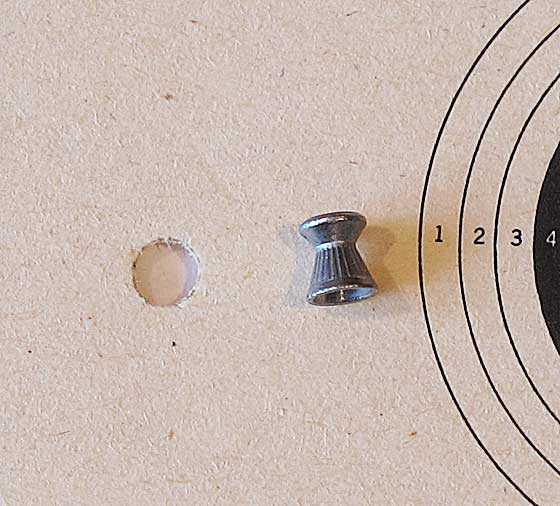
It’s pretty obvious why wadcutters are the darlings of the paper target crowd!
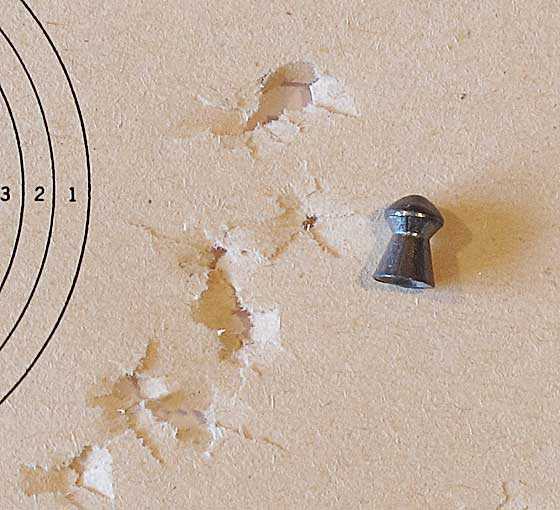
This is target paper, and yet these Beeman Kodiak domes leave a vague hole. Measure that!
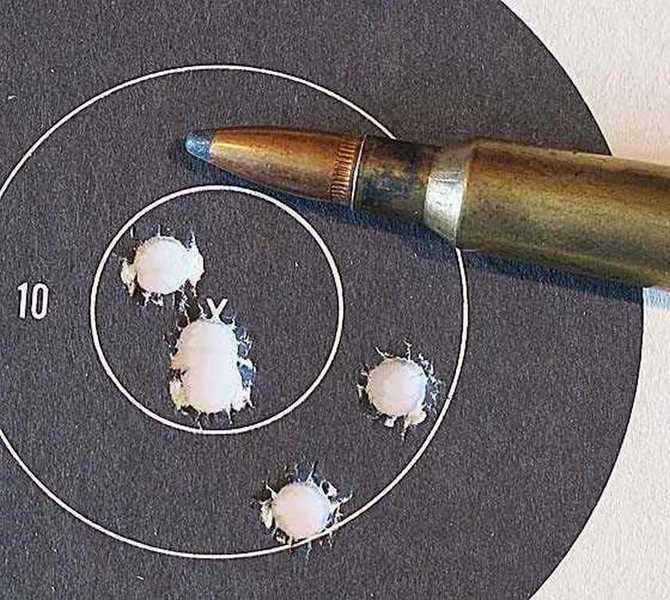
Even pointed bullets tear clean holes when they rip through targets at close to 3,000 f.p.s., like the 87-grain spitzers from this .250/3000 Savage.
Where the edge of the hole really is…is always a guess. Always! But with careful work, you can get the error range down to just a few tens of thousandths of an inch.
The equipment
I use dial calipers for measuring group sizes. I don’t own a digital caliper, so I’m relying on a caliper that has a mechanical dial calibrated in thousandths of an inch. Actually, the dial is just part of the measurement. For the gross measurement, you have to read the scale on the staff of the caliper, as well. The dial just gives you the final thousandths of an inch.
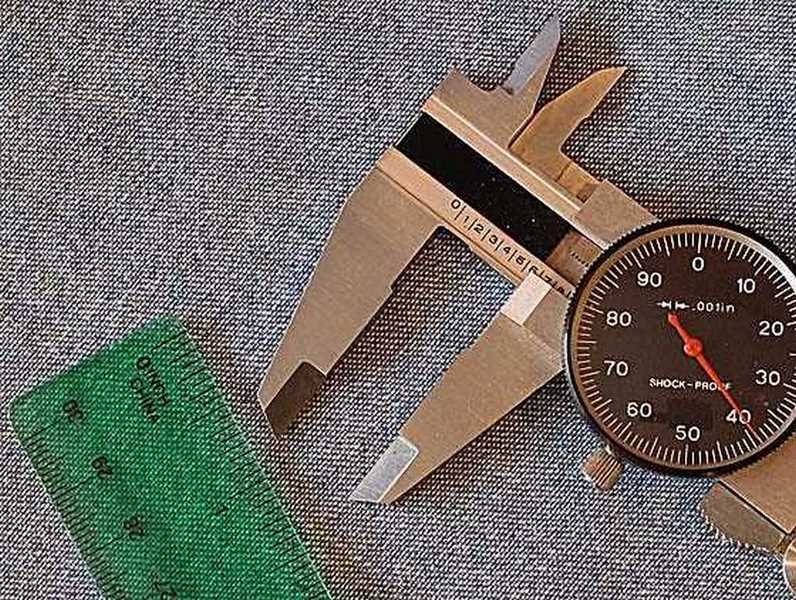
A dial caliper is an easy way to measure groups, but a ruler will do if that’s all you have.
When I measure groups, I do not look at the dial. I adjust the jaws until they just touch the edges of the two holes I’m measuring. This usually takes several attempts; and the stronger the light, the easier it is to be precise. The target paper must be flat to do this right, so the best way is to lay the target on a well-lit table and then place the dial caliper over the group and work the caliper jaws down until they touch just the edges of the holes. If there isn’t enough light on the target, I’ll use a powerful flashlight — a tactical flashlight — to illuminate the target.
Can groups be measured without a caliper?
Yes, they can. In that case, you need the most accurate ruler you can get your hands on. A steel machinist’s rule is the best tool to use. But lacking that, you can measure groups with an ordinary school-grade ruler. However, once you’ve taken the measurement, it’s best to convert to decimal fractions that run out to thousandths of an inch — because nobody will be impressed with a group that measures 3/8 inch, but everyone will admire a group that’s 0.375 inches! I’m joking, of course, but not as much as you would like me to be.
Finding the edge
Have you noticed that my groups often end up in the white target paper instead of in the black bullseye? My brother-in-law thinks that means the guns I shoot are inaccurate because they don’t hit the black bull — but I do it so I can find the edge of the pellet holes easier.
When you look for the edges of the holes, there are clues. Sometimes the pellets will leave a round lead ring where they tear through the paper. You can see this on the white target paper but not on the black. Other times there will be rips that extend radially away from the edge of the hole. These rips are part of the diameter of the pellet or bullet, as I will now show you.
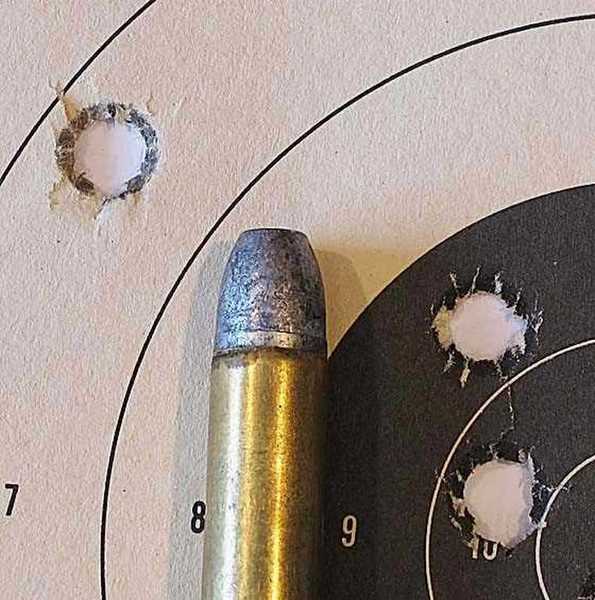
See how the bullet hole in the white stands out but in the black is obscure? Much easier to measure this .45/70 hole when it’s in the white. Notice, also, that the radial rips are part of the bullet’s diameter.
One way to get the best results is to push a pellet into one of the holes (try not to use either of the two measuring holes for this) and see how the skirt of the pellet passes through the hole. That will give you a good sense of where to put your caliper jaws in relation to the rips or the lead ring.
Accuracy
I’ve said this before, but it bears repeating: any group measured to the thousandth of an inch is off by up to twenty-five thousandth of an inch. I may have even said a larger error number than that.
Why are people so “inaccurate”? Well, do you know what twenty-five thousandths of an inch looks like? For your entertainment I will now illustrate how large that is.
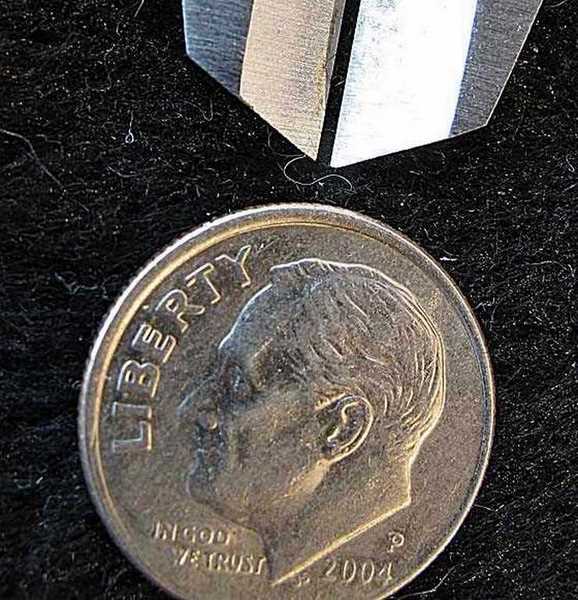
Twenty-five thousandths of an inch sounds big, but when you see it illustrated here as the space between the caliper jaws, it really isn’t. If you can measure a group this close to actual size you’re doing very good! The silver dime is on sabbatical, so this one is a stand-in.
When doctors disagree…
…who shall decide? If you could only attend one regional target match and watch competing coaches argue with the officials over measurements of a few thousandths of an inch, you would soon understand that measuring targets is an imperfect science. Always has been and probably always will be. At the Olympic and World Cup levels, the error has been reduced to less than a thousandth of an inch with sound transducers and triangulation…but it still isn’t exact.
What hope do we have?
If this all sounds like magic or hokum, consider this — the more often you do this the more uniform your measurements will become. You may never get the measurement exactly right, and there’s virtually NO way to prove that you did or didn’t, but you will tend to err in the same way time after time. In time, your measurements take on a standard error that’s based on YOU. You become the standard!

Well…I guess if you target shoot for a living you want precise measurement, or at least measurement in your favor. It is nice to have the measurements in the reports and I am sure that most of us realize that the last numeral is a guesstamite.
I prefer the coin rule most of the time myself, such as “I shot a dime size group” which means a dime will cover the rough center to center of the group or “I could cover the entire group with a dime” which is a much tighter group. It is easier to visualize such in a conversation, but it still leaves the error of interpretation.
B.B.s method of measurement and visualization is an excellent way to help relay the information. Plus, if he stopped using his dime he would be flooded with comments asking what happened to it. On sabbatical indeed. Don’t tell me you lost it, or did you just misplace it?
RR,
Misplaced — I hope! 🙂
B.B.
BB,
There is a definite smirk on the face of Roosevelt on this new dime. I think he bumped the old guy off.
-Chuck
Well gee whizz….
I thought you were supposed to shoot a tin of pellets and measure the distance between the three closest holes that landed on the paper, then divide by two, then multiply the distance to the target by five.
Really, most of the time I just use a tape measure and make a guess.
twotalon
Hi BB,
My apologies that I am off topic. If I trap a raccoon that comes late at night in a Havahart trap, does the Marauder Pistol have sufficient power to put it down at point blank range in the trap?
Thanks,
Jake
Jake,
If you have the nerve to put one into the brain, then the answer is yes.
B.B.
Thanks for the quick response. I assume what you are saying is it should always be a head shot when shooting Raccoons, and not anywhere else.
Thanks,
Jake
Jake,
Not always. But when you can control the shot, then yes. The brain lies on a line between the eye and ear canal. Or centered between the eyes if you are in front. But don’t miss by a half-inch, or the situation will get very ugly.
B.B.
Jake,
B.B. is exactly right about how ugly the situation can get when dispatching a raccoon.
I’ve had to perform that unpleasant chore when one got after my chickens some time back. The situation was the same as yours: one raccoon in a hav-a-hart trap, me with a pellet gun (Ruger AirHawk). The raccoon didn’t survive the encounter, but it was a close thing as even with the point-blank head shot. He did not go gently into that good night instead taking about 10 or 12 seconds to finally expire. Those were *exciting* 10 or 12 seconds, let me tell you. I truly don’t know how the trap survived because the raccoon did it’s best to imitate the Tasmanian Devil of the cartoon fame. An angry ‘coon is not something to trifle with.
With that being said, the Marauder pistol should certainly be enough gun for the job. Though, a shotgun would be better. Or a spear.
Having just shot my first .22 pistol competition, grouping size was not the issue. It was what ring your bullet landed in on the paper target, as probably everyone knows. Barely touching a ring was good enough to reward the shooter with the higher score. Unfortunately, I did not qualify for enough “rewards” and appear to have been crowned DLBF (dead last but finished in motorcycle enduro terminology). My pistol of choice is a .22 High Standard Military but it appears to have a flaw – it refuses to stay still when aiming on target :).
Seriously, my measurements of group size are done for two reasons with air rifles – One – to determine the most accurate pellet for the rifle and two, to see if the rifle will shoot accurately. A 10th of an inch difference in group size between two different pellets is close enough for me to decide I can use either pellet in that rifle. A 1/2″ or less size at 25 yards is considered outstanding accuracy and that pellet type and weight is noted. I don’t compare the group size to what others can do just because there are much better shooters then me out there. I also don’t “bench rest” my rifles but hold them with my elbow resting on something solid, like the table or port top at the range, or rest my arm flat on the same surface and lay the rifle on top of my arm – done when I’m unable to keep the rifle sights from wandering.
BB, if you spent that dime by mistake, you’ll have to come up with some other coin equally unique. Hopefully one that you found treasure hunting!
Fred DPRoNJ
Fred,
I have many silver dimes found while metal detecting, but the dime I showed was found in my change. I never spend change. I just roll it and turn it in at the bank. Edith bought me a mechanical bank that sorts the change for rolling.
So now I guess I have to look through three rolls of dimes, to see whether I accidentally put the dime into the machine! I would much rather find it on a table somewhere.
B.B.
Congratulations on your first pistol competition. If the criteria is finding what ring your shot touched, then defining the edge of the hole remains as important as for measuring groups.
Matt61
Matt, there has also been talk about occassionally doing .22 rifle competition at 25 yards. As I only have a 10-22 Ruger that I bought used and it occassionally throws off two rounds on one trigger squeeze (sort of like the combat burst mode), I casually asked if I could use my air rifle. The guys looked at each other, shrugged and responded, “I don’t see why not”. So, next I have to see if I can talk them into shooting .177 caliber. Then, I’ll have a choice of my Marauder or HW 55. (even my FWB 124). If everyone else is using a Ruger 10-22 and we bench rest, well I expect to uphold the honor of this blog! We’ll see.
Fred DPRoNJ
If you like your Ruger 10/22, you might consider getting a Timney drop in trigger group for it. It will get rid of the burst mode and give you a sweet 2 1/2 pound pull. I have one and it’s just great. I’ll be using it during our clubs Ruger Rimfire Challenge this year.
Mike
Thank you for that suggestion, Mike. I’ll give it a try!
Fred DPRoNJ
Mike,
$200 plus is a bit much for this rifle, I think. It’s fun but it will never be able to compete with top, bolt action rifles in bench rest. Do you have any other suggestions? Perhaps just ordering a replacement sear might be the best option?
Fred DPRoNJ
BB,
I believe you got this all wrong. It’s supposed to be like fish stories. The groups get smaller (or the fish gets bigger) with every recounting. Did I ever tell you about the time I shot a 1/4 inch group of 10 shots at 50 yards off hand with a spring powered pellet rifle? What was so amazing was that it was with open sights! Honest!
No witnesses? Technicality.
SE MN Airgunner.
You did it once? Pfff I can do it all the time! But I just do it when I’m by muself so I don’t embarass the people I’m shooting with 😉
J-F
I’d put my imaginary groups up against your imaginary groups any day of the week. I’m very imaginative.
Funny reply, thanks!
Just remember that the first liar always loses in games like this! You need to make sure you show your imaginary groups last.
BB,
When I saw that photo, my first thought was that you had accidentally spent “The Dime”!
An alternative for measuring groups would be to use a dividers. This is a measuring tool used in layout work and navigation. It is similar to a drawing compass with points on both legs instead of a point and a pencil. The dividers can be set with the points at any given distance apart and locked in position. This distance can then be transferred to a scale to get a measurement. It is cheaper than a calipers, but only as accurate as the scale it is measured with.
Les
If anyone has a need or desire to measure non-wadcutter groups accurately and easily, I have found a good way to get clean holes with pretty much any pellet, using pretty much any kind of paper. It involves using a duct seal trap with the surface smoothed out, and the paper placed directly on the duct seal. Here is an example I have handy that shows the results with .22 cal Baracuda pellets from my Marauder – note how much the holes look like wadcutters, even though the paper is plain copier paper and not even target paper: http://i1209.photobucket.com/albums/cc389/hkydad/BaracudaMatch-bestandworstat50yardsAug132011.jpg
In order to allow me to do this, I keep the deeper part of my ~2.5 inch deep duct seal trap well seasoned, but I clean out the top inch or so once or twice each year by digging it out and picking out the pellets (takes under 2 hours), and then smoothing it back out. Then it functions well enough that I can just roll it flat every couple of hundred shots if I need a smooth enough area to shoot a good measureable group again (most of the time I don’t care that much). Of course once the old pellets start to stack up in the duct seal, it does not work as well, thus leading to the need for another clean out. I do realize that this is probably too much work for somebody like BB that shoots more groups in a week than I do in six months, but it is an option for the rest of us, or even for a separate trap dedicated to accurate group measurements vs. chrony work and general shooting.
I have learned not to leave the paper on the duct seal for too long, or it pretty much gets glued into place . . . .
Alan,
You didn’t say how you smoothed out the duct seal. I have tried to do it by hand but just can’t get it flat. After digging out pellets, there are too many deeply mangled holes to get a good smooth surface back.
-Chuck
When I do a clean out, or when I have shot a lot into an area, I use a hammer to pound the duct seal into an approximately flat shape – say to about +/- 0.25″ of level. Then I use a piece of 2″ diameter PVC drain pipe that is about 8″ long, and I roll it flat, working in both up/down and right/left directions across the rectangular trap.
The pipe works real well, even for just closing up the holes and re-leveling it after a bunch of shooting.
My trap is larger than an 8.5×11 sheet of paper, so I made up a sheet that I can print out that has 25 “official” sized benchrest (darn close, anyways) bulls on it, and I can shoot a bunch of those by just moving the sheets of paper around slightly so that the center of the bulls are over a fresh patch of duct seal. And after about 6 or 7 sheets, I re-roll the trap, and it only takes a few minutes. Makes it REAL easy to accurately score the 10’s and x’s . . . .
Alan,
Thanks for the info. I like the PVC pipe idea – maybe fill it with lead? I think you’ve given me another use for the lead ingots I’ve been making from used pellets.
-Chuck
25 thousandths of an inch actually doesn’t sound big to me at all. 🙂
While wadcutters leave cleaner edges, they can also make your groups look bigger. The holes I shoot with my JSB exacts leave smaller holes than the RWS Hobbys. But that could be due to other factors. The JSBs, powered by my B30, blow right through the paper whereas the RWSs from the IZH 61 go slowly enough to tear the paper.
While calipers are great for measuring with precision, they would never keep up with the number of groups I shoot. My group measuring criteria is first whether the holes are contiguous or not. If contiguous, it’s a question of whether I can identify any individual holes or not. That pretty much tells me the story in a glance.
Mike, thanks for the info about the M1917. I wonder why anyone would prize cock on opening over cock on closing outside of familiarity. The cock on closing of the Lee-Enfield feels far superior to me in every way. My understanding of the cock on opening design is that it is part of a very strong and well-designed action, but it doesn’t offer intrinsic benefits for handling.
B.B., interesting about the windage of the 1917 which I agree is a huge disadvantage. I’m waiting with some anxiety to see how my Lee-Enfield shoots since it has no windage adjustment.
Matt61
Matt,
I’ll bet your rifle will be well-centered. For all our bragging, sometimes the U.S. arsenal program did shoddy work. Especially when the work was done by contractors outside the arsenals, themselves.
I have never found that to be true of the UK arsenals. My No. IV is right on for windage and I bet yours will be too.
B.B.
Interesting. I had a Savage Arms produced No 4 Mark I* that was way off for windage. I got rid of that one. The British and Canadian No 4’s I have had have all been spot on for windage.
Mike
Mike,
Now, that IS interesting!
B.B.
Now that that you educated me on measuring group sizes, what do you consider decent group sizes for a lower end (under $200) springer? Would you consider 1.25″ groups at 40 yards decent for a scoped .177 springer at 810 fps with 10 grain pellets? This would be using a rest. I get similar groups using 8 grain at 910 fps, but it doesn’t take much of a breeze to move those lighter pellets off center.
TC,
As long as you are talking 10-shot gropus of that size, that is acceptable. If you are talking only 5-shot groups then that’s a bit large.
B.B.
BB,
OK, that helps. At 10 yards, I’m 1/4″ or less with either pellet based on 5 shot groups. As the distance increases it feels like more room for error when trying to stay on the exact target center point. I use 1″ solid black circles for longer distances (20-40 yards). Maybe that is too big. I tried different scope powers. Around 7X works best. My goal is 1″ at 50 yards. A good excuse to trade up to a PCP.
TC,
I’m going to make a few suggestions that will hopefully help you meet your shooting goal.
Since your gun is scoped I suggest that you use a smaller aimpoint at 20-40 yards. Make a red dot on your white target paper with a red pen or felt tip pen that is just slightly larger than a pellet hole. If you can’t see the red aimpoint through your scope slightly enlarge it.
Two reasons for this suggestion. First, Black 1″ circles for an aimpoint when using black crosshairs are challenging. Second, there is an old shooting cliche’ for improving accuracy………”aim small, miss small.” By shrinking your aimpoint your groups should also shrink with practice.
kevin
I found I shoot better groups with a scope when I ignore the center/crossing and try to divide the target circle into four equal parts with the vertical and horizontal elements of the crosshairs. This works equally well with smaller or larger circles. I know what Kevin is saying with “aim small miss small” and you should try it also; it works well for many, but I guess I’m weird :)! If the target is one with vertical and horizontal lines (or numbers arrayed so they can be used that way), it is even better — just use them to line up the cross-hair elements. Figure out which works best for you — a smaller circle focusing on the center, or a hill-billy zen, outside-in approach to groups :). Of course, it only works for groups, but shooting for groups is about the only time groups matter anyway!
Oh my stars and garters! BG_Farmer using a scope? I think I am getting the vapors. ;-P
Only jazzing you BG. Your suggestion of shooting open sights more often sharpens my skills, and even helps with my scoped rifle shooting due to the discipline involved. It is a shame my most accurate rifles have no means of mounting open sights.
SL,
I didn’t say I like shooting groups with a scope, just how it worked best for me :)! I just thought the technique is a little interesting (maybe a product of my deranged mind) and complementary to the conventional one. What I like about it also, was that it allows shooting groups with lower magnification that are very comparable to high-mag groups using the conventional method — but that may just be me! I got similar advice from a friend when 50 yard small bull target shooting started kicking my behind with the flintlock and open sights, and changing the approach broke the vicious cycle of trying to hit the exact center (I’m lucky to see the black portion of the bull!) and choking, leading ironically to more hits near the center, at least when I’m on a streak!
Great suggestions. I’ll try a smaller aim point. I’m trying to master BG_Farmers approach of equal parts because allows one to center on any size target quickly.
I’m new to this business, so a beginners target-related question. I’m shooting an AA TX200 at 25 yds from a rest. I find when using target images (with multiple targets on each page) acquired free on the Internet I receive vastly different accuracy/grouping as I move from target to target on the page. In some cases there are a dozen small targets on each page. Is this normal, or a deficiency in my technique that could be corrected. Finally, in bench rest competition is only one target used per page obviating this problem. Thank you.
Captainbob,
I think your problem is concentration. More than one target (bullseye) per target is confusion or distracting you.
In competition sometimes shooters have 12 bulls on a target and sometimes there is only one. It depends on the level of the competition.
The key phrase you should concentrate on is, “Aim small, miss small.”
B.B.
I haven’t been doing this long, but I’ve been using a cheap plastic caliper and actually just measuring center to center. At least for me the center is pretty easy to see where the edge is more fudgy. The one thing I don’t like is the stock measurements are in 16ths. I usually convert to nearest tenth in my head which isn’t all that difficult.
So far my shooting sucks. I’m shooting at best 1″ (10rd) groups at 11yds with a Gamo Whisper 1200 177 and crosman HP premiums. I have recently started concentrating on touching or getting in the bulls-eye and have got as much as 8 out of ten there. I think if I start doing it very consistently I’ll start only counting the ones that are center in and then maybe move to clear in.
I have the new Benjamin 22 1100 NP XL but I managed to hurt my arm cocking it. I’m going to build up my arm with the Gamo and then see how I do.